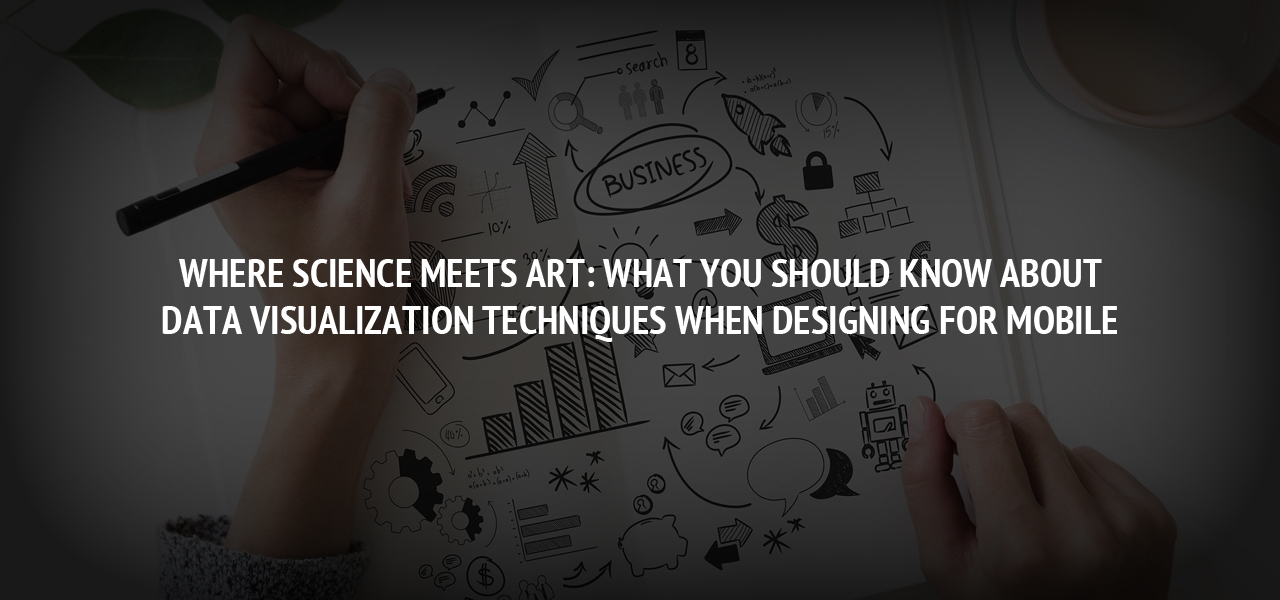Where Science Meets Art: What You Should Know About Data Visualization Techniques When Designing for Mobile

It’s impossible to imagine our lives without smartphones. We use our phones as work tools, wallets, cameras, GPS systems, music players, etc. Phones are not only useful but they are also a constant source of instant gratification. Thanks to mobile phones, people expect to get everything they need in just a few seconds, simply moving their fingers on a screen. Instant gratification becomes an important competitive advantage, and this principle applies not only to online purchases or search results but also to data insights, as well.
Given that we generate massive amounts of data every day, moving it to mobile and ensuring fast work can be a challenging task. Fortunately, there is an approach that allows designers and developers to achieve several goals at once — it’s data visualization. Instead of providing an overwhelming amount of detailed data, data visualization allows for quick comprehension of the meaning of a certain set of data. Effective data visualization practices allow you to not only provide information but also increase engagement and conversion rates. But first, let’s figure out what data visualization is.
What Data Visualization Is and Why You Should Use It
Data visualization is a term that describes methods of communicating data insights through visual representation. It allows designers to present large datasets in a way that’s easy to understand, illustrating important relationships within the data. The term “data visualization” is also used interchangeably with such terms as “information visualization,” “statistical graphics,” and “information graphics.”
Data visualization allows for providing insights more effectively than traditional descriptive statistics because visualized data allows the audience to detect important patterns. Obviously, such an approach allows for quicker decision-making, providing the audience with actionable insights that otherwise would remain unnoticed. Besides, modern internet users love visual content and are 40 times more likely to share it on social media.
Main Data Visualization Techniques for Mobile
-
Use the capabilities of mobile devices
Although designing visuals for mobile may seem difficult, the truth is that phones have a lot to offer in terms of design solutions. For instance, you can offer personalized data using GPS tracking or use notifications for alerts. We also recommend that you present different graphs for a portrait and landscape mode. For example, users can turn their phones to switch from a pie chart to a more detailed bar chart. Here’s an example of a visual that looks completely different in the portrait and landscape mode. Another good solution is to enable a zoom-in feature so that users can get more detailed information about a certain data set by zooming on the corresponding section of the graph or clicking on it.
-
Use touchscreen controls
You can add interactive elements to your mobile data visualization by using touchscreen controls. For instance, users can swipe a large graph to work with it on a small screen or touch various elements of the chart to see more detailed information. First, such interactive features allow you to present more information. Secondly, they create a great user experience, making interaction with your product more engaging. Don’t be afraid to experiment and try different approaches. Here’s a good example of an interactive and very informative visual.
-
Keep it simple
Make sure that your widgets are easy to read. You don’t want users to feel overwhelmed by too many elements and too much text on a small screen. It’s better to create a few widgets with different sorts of data instead of trying to fit as much data as you can into one widget. Don’t forget that users want to understand data quickly. Therefore, stick with simple charts, short titles, and big numbers. You may also consider replacing some textual elements with icons.
-
Consider different mobile OS
To make sure that both Android and iOS users will see your graphs clearly, you can use proven data visualization libraries that address the differences between various types of hardware, platforms, and browsers. Frameworks aimed for one platform may provide a poor experience for the users of another platform because of the differences in browsing and navigation, so we recommend that you choose mobile frameworks carefully. We also suggest that you choose a responsive layout design so that the size of your graphs and their elements can change depending on the screen resolution.
Conclusion
Although designing visuals for mobile devices may seem more difficult, the truth is that mobile platforms also offer a greater level of flexibility and enable you to present data in interesting and creative ways. Users are looking for an easy experience so we recommend that you make your data visuals simple, interactive, and adaptive. Take advantage of different screen modes, zooming, and other features of mobile devices. Besides, don’t forget to make sure that your visuals look equally great on different platforms.
About The Author
Related Blog
View All-
Top Ten Best Android Games 2017 ? Free Download Here
Best Android Games of 2017 That You Need to Play at Once We entered in 2017 but still, we feel like it's just started so here I'm gonna discussing Best Android Games 2016. Yeah, some of you might not know about these Best Free Android Games. ...
-
6 Tricks To Optimize Your Android Application For Better UI.
Smartphones are the first thing that comes to mind when a person wakes up in the morning, this is the kind of reliability, we have on smartphones. Then there is the popularity of Android as an OS. Android applications are on the rise and they have been the popular ...







